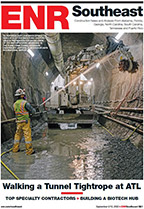 |
| Blowout. Inquiry committee found that the retaining wall system was inadequate. (Photo courtesy of Singapore LTA) |
Serious prosecution and possible blacklisting await Japans Nishimatsu Construction Co. and three of its senior officials who were directly involved in the construction and subsequent collapse of the 100-meter rail tunnel in Singapore on April 20, 2004. An official investigation has revealed that the tunnel work was underdesigned and poorly executed, indicating that a more serious accident could have taken place if the project had not been interrupted by the accident that killed four people.
The Singapore government on May 17 said it planned to blacklist Nishimatsu, and that it had accepted the 100-page report delivered by the Committee of Inquiry on May 13 after 13 months of deliberation. The government said it also was taking steps to implement the inquiry committees many suggestions on improving safety on major projects and prosecuting six officials for failing to stop the work in the face of evidence that the tunnel might give in. One is a senior engineer of the project owner, the state-owned Land Transport Authority
The committee found three main causes for the collapse of the tunnel, known as project C824. One was the use of an inappropriate soil simulation model, which overestimated the soil strength at the accident site and underestimated the forces on the retaining walls within the excavation. The committee also said there was an error in the design of the strut-waler support system, with the connections being underdesigned. Deviations in actual construction aggravated the conditions, the end result being a system that was about 50% weaker than it should have been, the committee said.
"The collapse falls squarely on the builder, Nishimatsu-Lum Chang Joint Venture," said the three-member inquiry team, led by Senior District Judge Richard Magnus. It was surprised that the contractor had manipulated charts to cover up the fact that the retaining walls were bending more than predicted. "Back analysis to assess safe continuation of excavation works became mathematical curve-fitting exercises," it said.
The committees report raises serious questions about quality standards in construction projects in Singapore, as it lists a wide range of human and systemic failures. However, it suggested prosecution of only one LTA official while saying that LTAs director of projects and the engineer of C824, Rajan Krishnan, and the project manager, Wong Hong Peng be "counseled." It did not explain what kind of counseling was called for.
"The responsibility for the contract was on Nishimatsu, which is why the COI pointed the blame on them. But they also have pointed to weaknesses at LTA and we will...make sure the weaknesses are corrected," says Singapore Transport Minister Yeo Cheow Tong.
The committee also found evidence of inadequate instrumentation and monitoring of works, improper management of instrumentation data, lack of competency of persons carrying out specialized work and incapacity of the project management team and supervisory personnel to identify adverse trends in the construction and take corrective measures. It also said there were problems in the project chain of command and communications and a lack of clarity in the reporting structure for decision-making.
The committee said Nishimatsu should be prosecuted under the Factories Act for failing to ensure that the retaining wall system was sound and the work site was safe. It could be fined $120,000. The committee said Nishimatsu project director Shun Sugawara, project co-coordinator Paul Broome and design manager Kazuo Shimada each could be fined up to $120,000 and/or jailed up to 12 months, if convicted. It said that Ng Seng Yoong, the qualified person representing LTA at the site, if convicted, could be fined up to $6,000 or jailed up to six months for breaching his statutory duties under the Building Control Act.
In response to the findings, the government says it is working on an Excavation Code for deep excavations and that licensing would be introduced for specialist contractors engaged in critical geotechnical work, such as soil investigation and instrumentation. Nishimatsu officials were unavailable for comment.


Post a comment to this article
Report Abusive Comment